Tata Steel Europe: Leadership & Management Concepts in Operations
VerifiedAdded on 2024/05/15
|21
|5473
|451
Report
AI Summary
This report provides an analysis of leadership and management concepts within Corus, a part of the Tata Steel Group. It discusses the characteristics and roles of leaders and managers, comparing Ratan Tata and Henrik Adam as examples. Various management and leadership theories, including situational leadership, systems leadership, and contingency theory, are applied to different organizational situations within Corus. The report assesses the strengths and weaknesses of these approaches in the work environment, examining how leadership and management functions apply in various situational contexts, such as slow, fast, and moderate changes. The analysis incorporates academic definitions of leadership and management, highlighting the importance of adapting leadership styles to different organizational needs and challenges. This document is available on Desklib, a platform offering a wide range of study tools and resources for students.
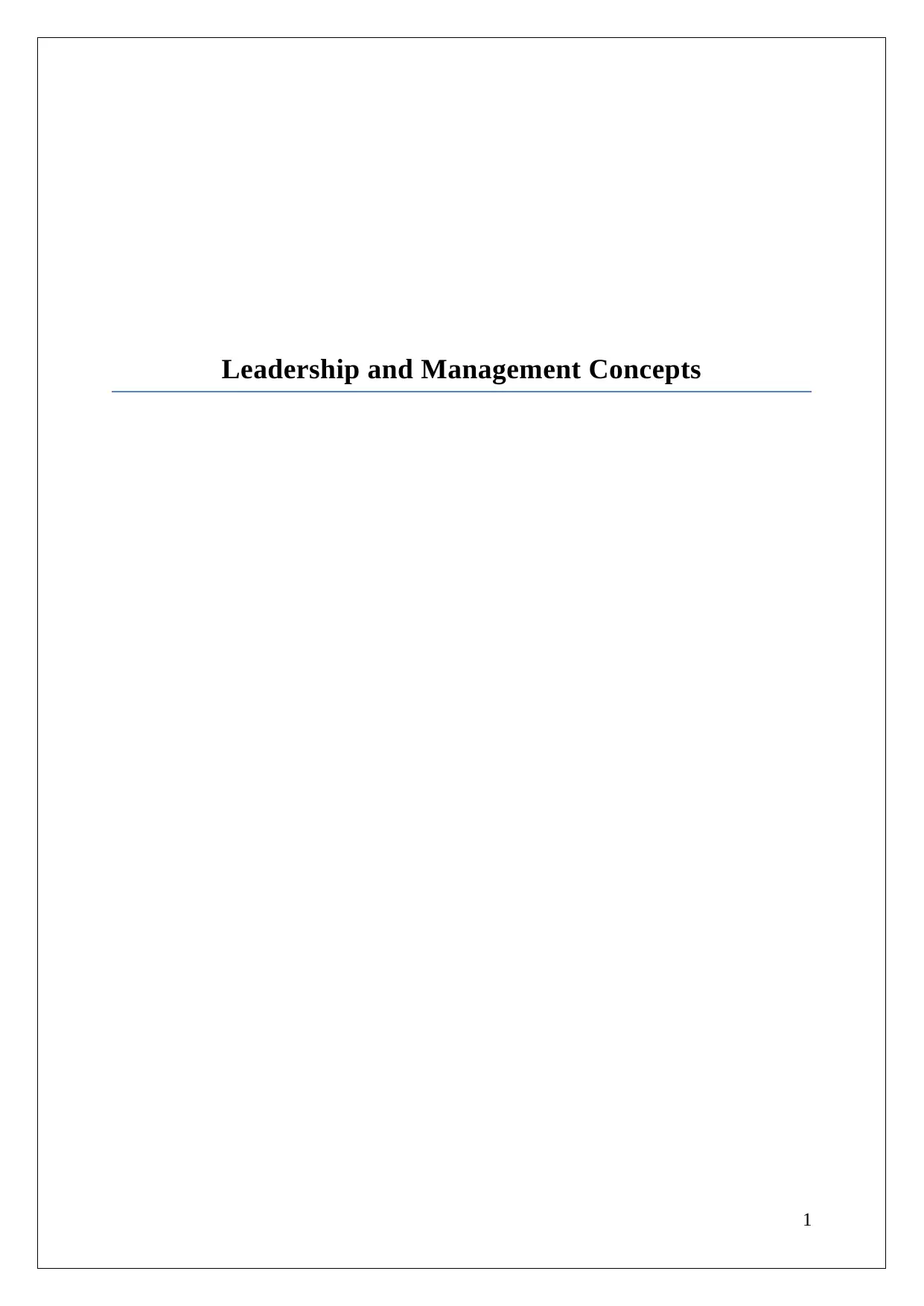
Leadership and Management Concepts
1
1
Paraphrase This Document
Need a fresh take? Get an instant paraphrase of this document with our AI Paraphraser
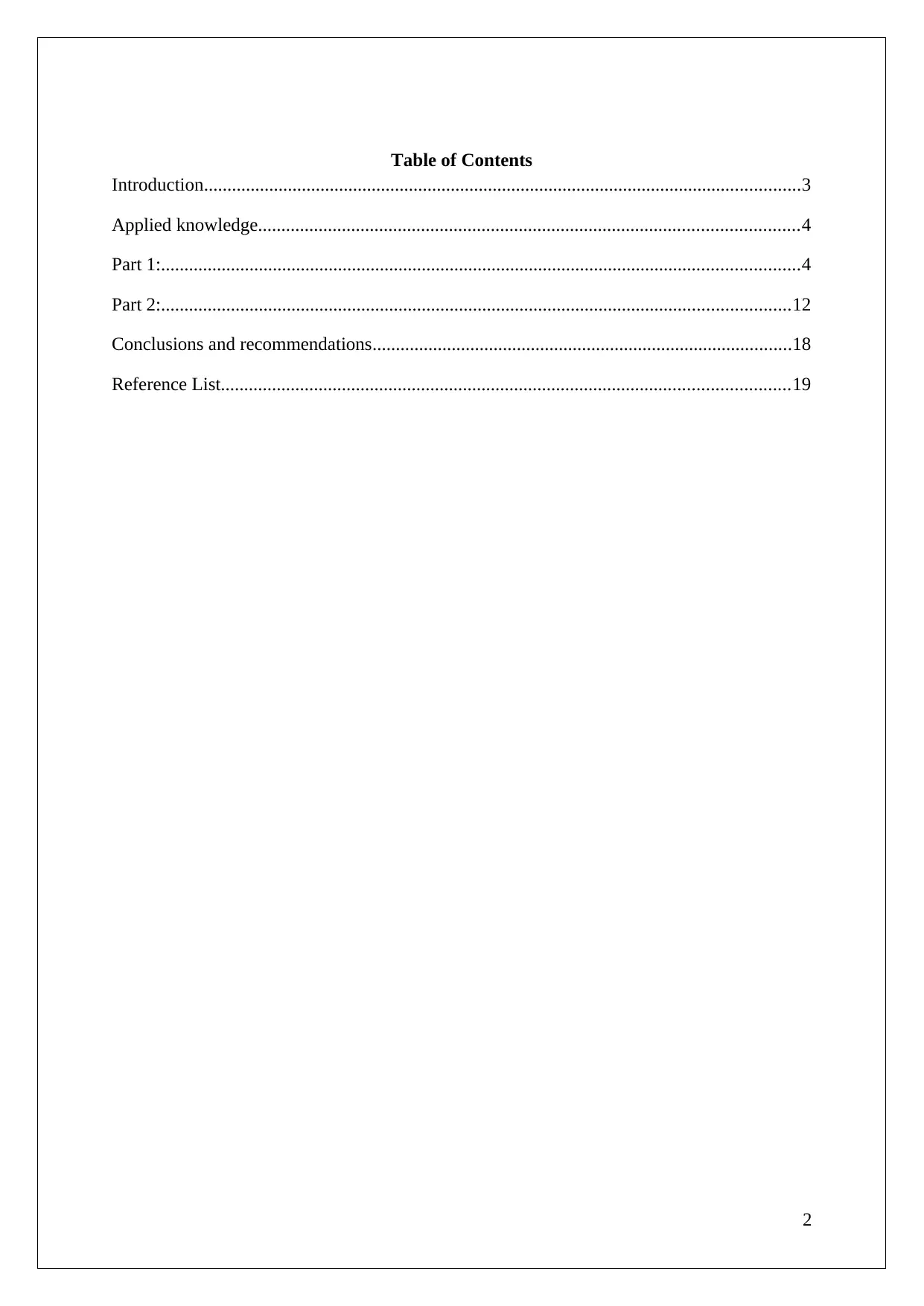
Table of Contents
Introduction................................................................................................................................3
Applied knowledge....................................................................................................................4
Part 1:.........................................................................................................................................4
Part 2:.......................................................................................................................................12
Conclusions and recommendations..........................................................................................18
Reference List..........................................................................................................................19
2
Introduction................................................................................................................................3
Applied knowledge....................................................................................................................4
Part 1:.........................................................................................................................................4
Part 2:.......................................................................................................................................12
Conclusions and recommendations..........................................................................................18
Reference List..........................................................................................................................19
2
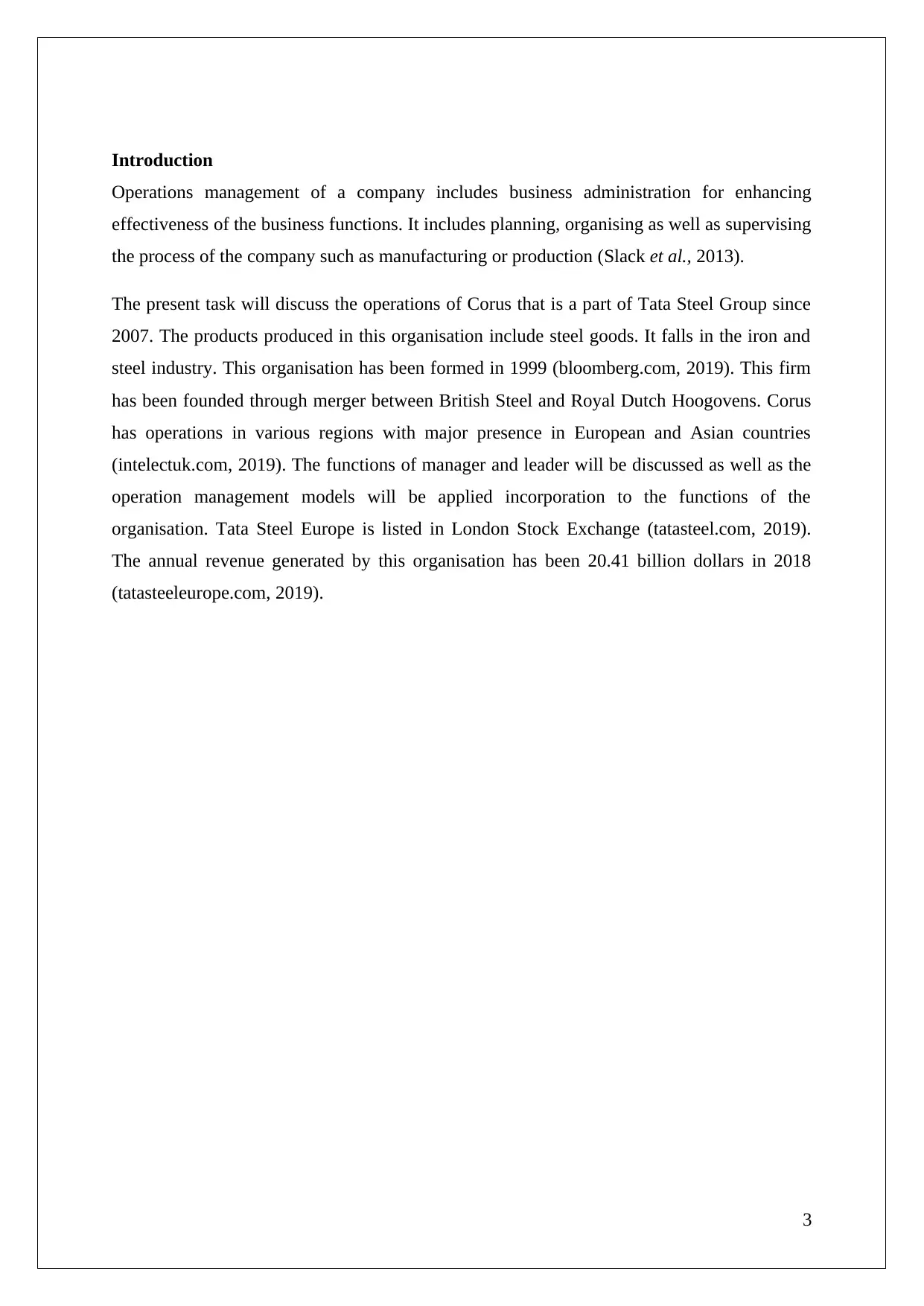
Introduction
Operations management of a company includes business administration for enhancing
effectiveness of the business functions. It includes planning, organising as well as supervising
the process of the company such as manufacturing or production (Slack et al., 2013).
The present task will discuss the operations of Corus that is a part of Tata Steel Group since
2007. The products produced in this organisation include steel goods. It falls in the iron and
steel industry. This organisation has been formed in 1999 (bloomberg.com, 2019). This firm
has been founded through merger between British Steel and Royal Dutch Hoogovens. Corus
has operations in various regions with major presence in European and Asian countries
(intelectuk.com, 2019). The functions of manager and leader will be discussed as well as the
operation management models will be applied incorporation to the functions of the
organisation. Tata Steel Europe is listed in London Stock Exchange (tatasteel.com, 2019).
The annual revenue generated by this organisation has been 20.41 billion dollars in 2018
(tatasteeleurope.com, 2019).
3
Operations management of a company includes business administration for enhancing
effectiveness of the business functions. It includes planning, organising as well as supervising
the process of the company such as manufacturing or production (Slack et al., 2013).
The present task will discuss the operations of Corus that is a part of Tata Steel Group since
2007. The products produced in this organisation include steel goods. It falls in the iron and
steel industry. This organisation has been formed in 1999 (bloomberg.com, 2019). This firm
has been founded through merger between British Steel and Royal Dutch Hoogovens. Corus
has operations in various regions with major presence in European and Asian countries
(intelectuk.com, 2019). The functions of manager and leader will be discussed as well as the
operation management models will be applied incorporation to the functions of the
organisation. Tata Steel Europe is listed in London Stock Exchange (tatasteel.com, 2019).
The annual revenue generated by this organisation has been 20.41 billion dollars in 2018
(tatasteeleurope.com, 2019).
3
⊘ This is a preview!⊘
Do you want full access?
Subscribe today to unlock all pages.

Trusted by 1+ million students worldwide
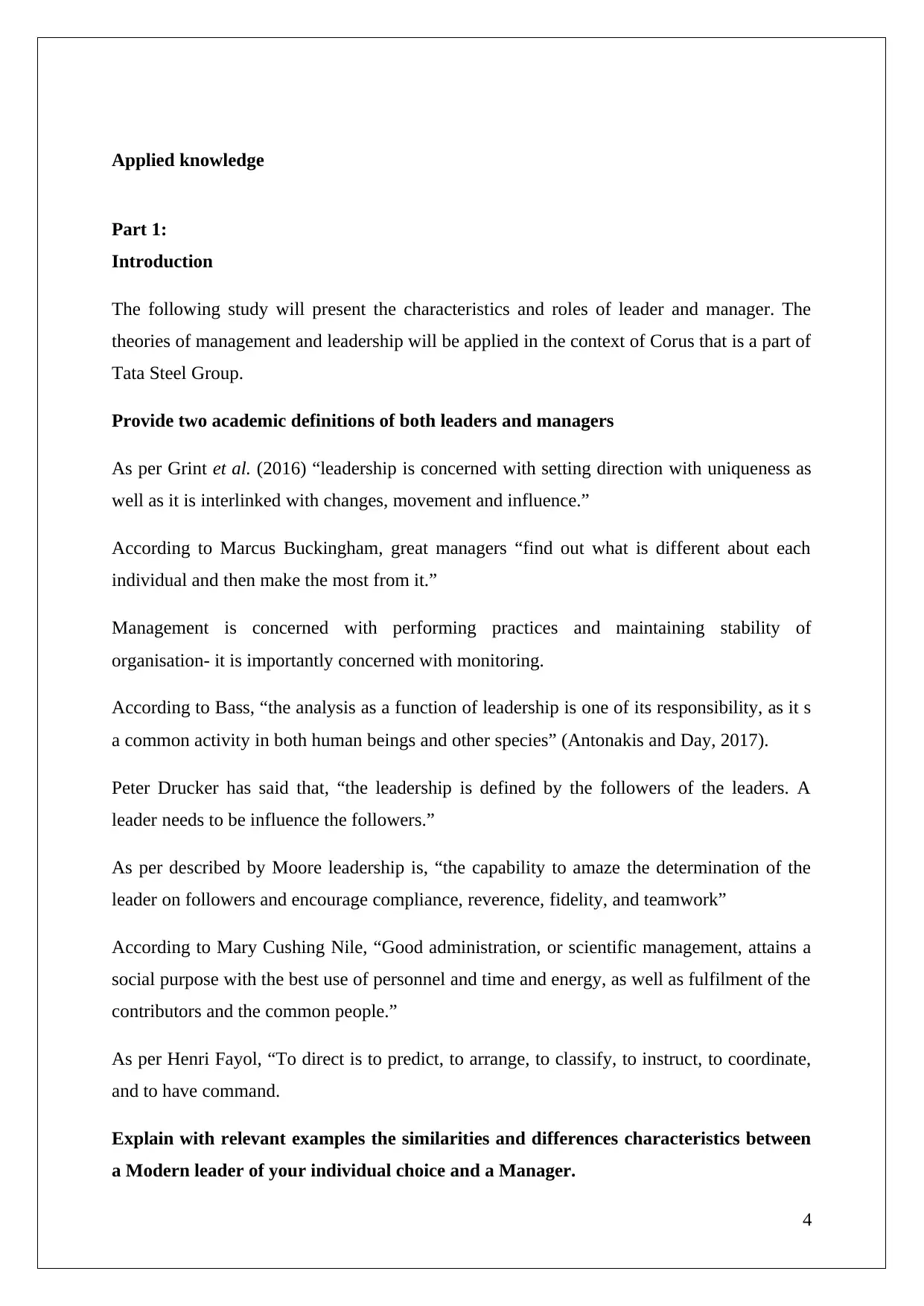
Applied knowledge
Part 1:
Introduction
The following study will present the characteristics and roles of leader and manager. The
theories of management and leadership will be applied in the context of Corus that is a part of
Tata Steel Group.
Provide two academic definitions of both leaders and managers
As per Grint et al. (2016) “leadership is concerned with setting direction with uniqueness as
well as it is interlinked with changes, movement and influence.”
According to Marcus Buckingham, great managers “find out what is different about each
individual and then make the most from it.”
Management is concerned with performing practices and maintaining stability of
organisation- it is importantly concerned with monitoring.
According to Bass, “the analysis as a function of leadership is one of its responsibility, as it s
a common activity in both human beings and other species” (Antonakis and Day, 2017).
Peter Drucker has said that, “the leadership is defined by the followers of the leaders. A
leader needs to be influence the followers.”
As per described by Moore leadership is, “the capability to amaze the determination of the
leader on followers and encourage compliance, reverence, fidelity, and teamwork”
According to Mary Cushing Nile, “Good administration, or scientific management, attains a
social purpose with the best use of personnel and time and energy, as well as fulfilment of the
contributors and the common people.”
As per Henri Fayol, “To direct is to predict, to arrange, to classify, to instruct, to coordinate,
and to have command.
Explain with relevant examples the similarities and differences characteristics between
a Modern leader of your individual choice and a Manager.
4
Part 1:
Introduction
The following study will present the characteristics and roles of leader and manager. The
theories of management and leadership will be applied in the context of Corus that is a part of
Tata Steel Group.
Provide two academic definitions of both leaders and managers
As per Grint et al. (2016) “leadership is concerned with setting direction with uniqueness as
well as it is interlinked with changes, movement and influence.”
According to Marcus Buckingham, great managers “find out what is different about each
individual and then make the most from it.”
Management is concerned with performing practices and maintaining stability of
organisation- it is importantly concerned with monitoring.
According to Bass, “the analysis as a function of leadership is one of its responsibility, as it s
a common activity in both human beings and other species” (Antonakis and Day, 2017).
Peter Drucker has said that, “the leadership is defined by the followers of the leaders. A
leader needs to be influence the followers.”
As per described by Moore leadership is, “the capability to amaze the determination of the
leader on followers and encourage compliance, reverence, fidelity, and teamwork”
According to Mary Cushing Nile, “Good administration, or scientific management, attains a
social purpose with the best use of personnel and time and energy, as well as fulfilment of the
contributors and the common people.”
As per Henri Fayol, “To direct is to predict, to arrange, to classify, to instruct, to coordinate,
and to have command.
Explain with relevant examples the similarities and differences characteristics between
a Modern leader of your individual choice and a Manager.
4
Paraphrase This Document
Need a fresh take? Get an instant paraphrase of this document with our AI Paraphraser
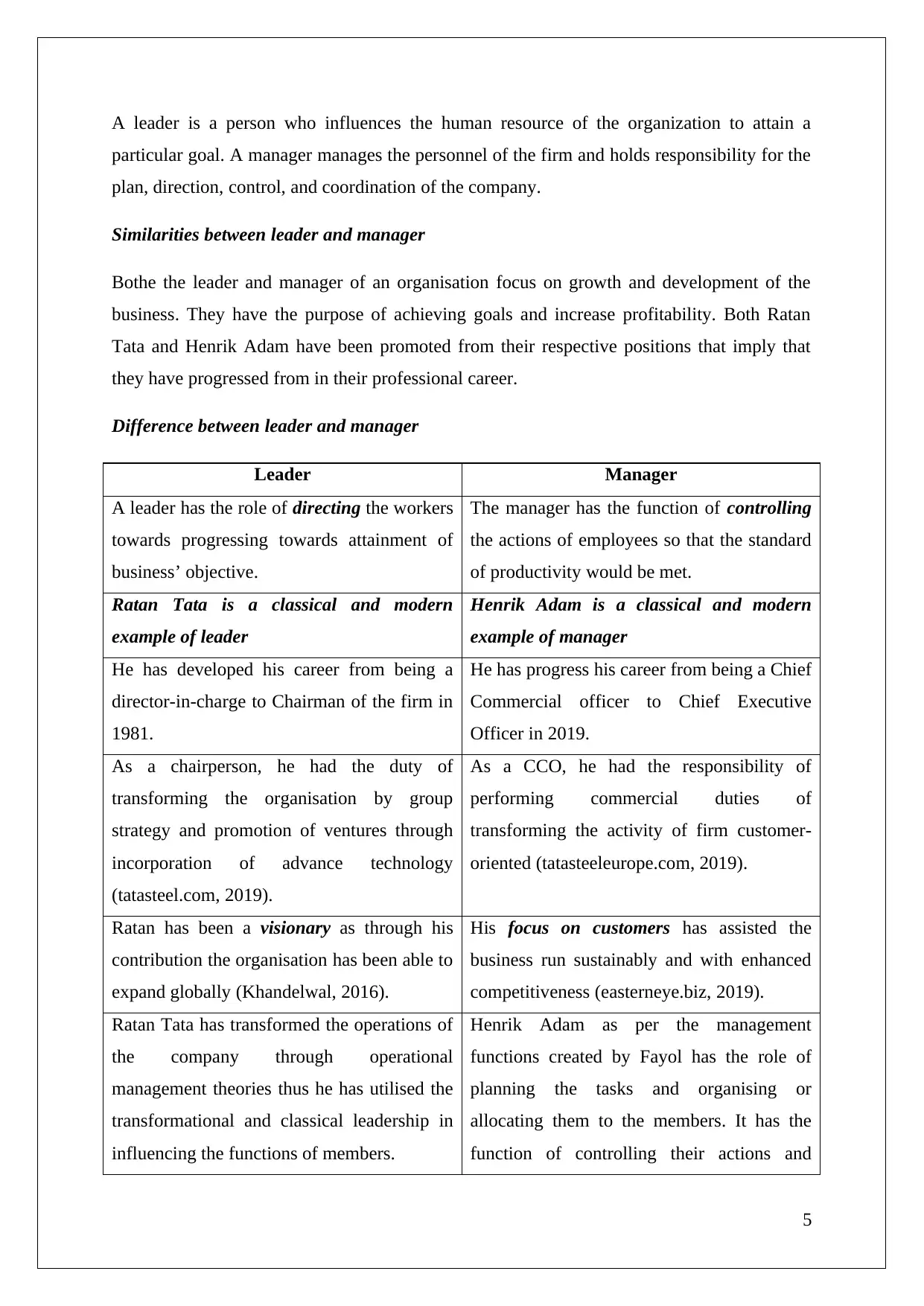
A leader is a person who influences the human resource of the organization to attain a
particular goal. A manager manages the personnel of the firm and holds responsibility for the
plan, direction, control, and coordination of the company.
Similarities between leader and manager
Bothe the leader and manager of an organisation focus on growth and development of the
business. They have the purpose of achieving goals and increase profitability. Both Ratan
Tata and Henrik Adam have been promoted from their respective positions that imply that
they have progressed from in their professional career.
Difference between leader and manager
Leader Manager
A leader has the role of directing the workers
towards progressing towards attainment of
business’ objective.
The manager has the function of controlling
the actions of employees so that the standard
of productivity would be met.
Ratan Tata is a classical and modern
example of leader
Henrik Adam is a classical and modern
example of manager
He has developed his career from being a
director-in-charge to Chairman of the firm in
1981.
He has progress his career from being a Chief
Commercial officer to Chief Executive
Officer in 2019.
As a chairperson, he had the duty of
transforming the organisation by group
strategy and promotion of ventures through
incorporation of advance technology
(tatasteel.com, 2019).
As a CCO, he had the responsibility of
performing commercial duties of
transforming the activity of firm customer-
oriented (tatasteeleurope.com, 2019).
Ratan has been a visionary as through his
contribution the organisation has been able to
expand globally (Khandelwal, 2016).
His focus on customers has assisted the
business run sustainably and with enhanced
competitiveness (easterneye.biz, 2019).
Ratan Tata has transformed the operations of
the company through operational
management theories thus he has utilised the
transformational and classical leadership in
influencing the functions of members.
Henrik Adam as per the management
functions created by Fayol has the role of
planning the tasks and organising or
allocating them to the members. It has the
function of controlling their actions and
5
particular goal. A manager manages the personnel of the firm and holds responsibility for the
plan, direction, control, and coordination of the company.
Similarities between leader and manager
Bothe the leader and manager of an organisation focus on growth and development of the
business. They have the purpose of achieving goals and increase profitability. Both Ratan
Tata and Henrik Adam have been promoted from their respective positions that imply that
they have progressed from in their professional career.
Difference between leader and manager
Leader Manager
A leader has the role of directing the workers
towards progressing towards attainment of
business’ objective.
The manager has the function of controlling
the actions of employees so that the standard
of productivity would be met.
Ratan Tata is a classical and modern
example of leader
Henrik Adam is a classical and modern
example of manager
He has developed his career from being a
director-in-charge to Chairman of the firm in
1981.
He has progress his career from being a Chief
Commercial officer to Chief Executive
Officer in 2019.
As a chairperson, he had the duty of
transforming the organisation by group
strategy and promotion of ventures through
incorporation of advance technology
(tatasteel.com, 2019).
As a CCO, he had the responsibility of
performing commercial duties of
transforming the activity of firm customer-
oriented (tatasteeleurope.com, 2019).
Ratan has been a visionary as through his
contribution the organisation has been able to
expand globally (Khandelwal, 2016).
His focus on customers has assisted the
business run sustainably and with enhanced
competitiveness (easterneye.biz, 2019).
Ratan Tata has transformed the operations of
the company through operational
management theories thus he has utilised the
transformational and classical leadership in
influencing the functions of members.
Henrik Adam as per the management
functions created by Fayol has the role of
planning the tasks and organising or
allocating them to the members. It has the
function of controlling their actions and
5
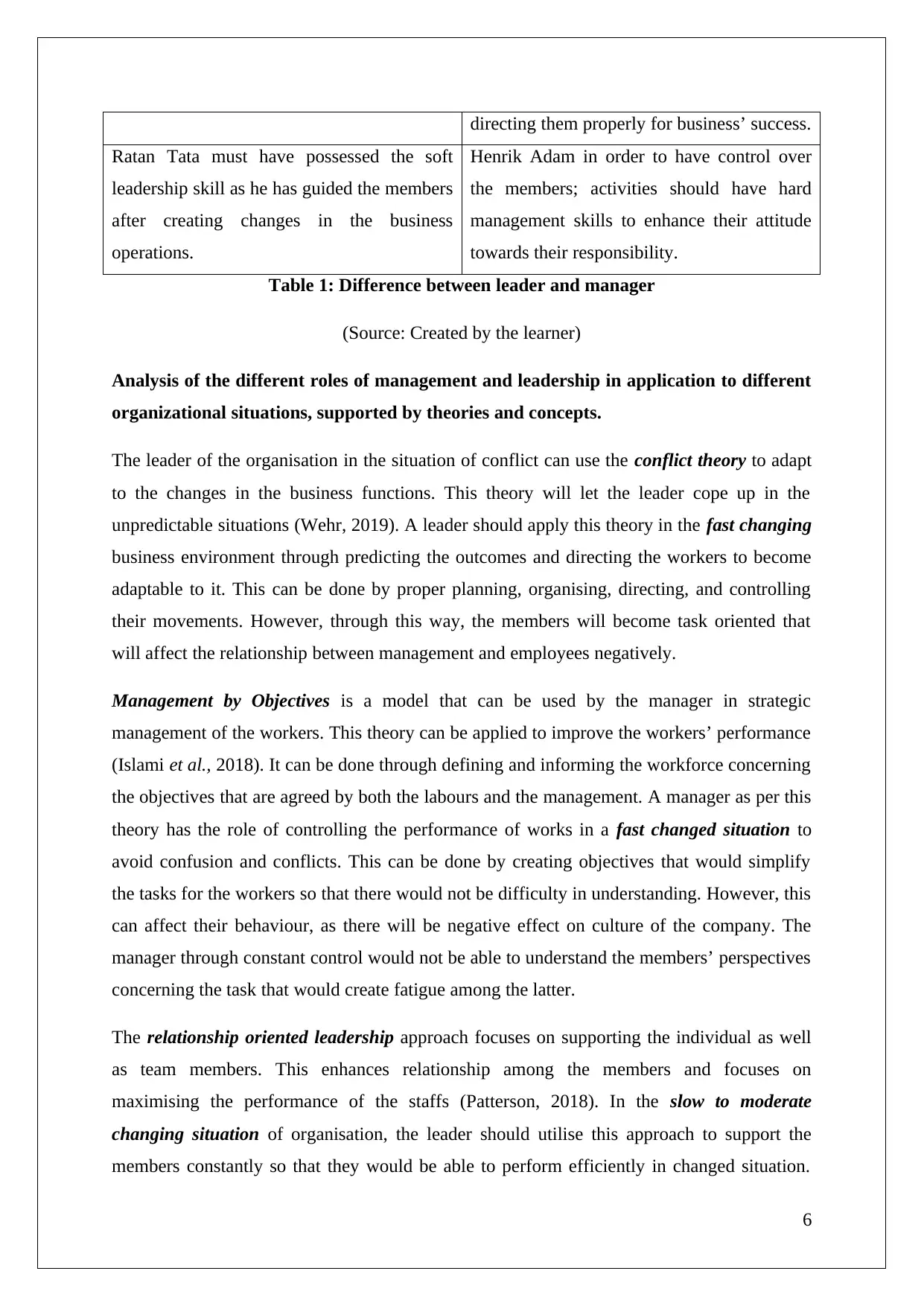
directing them properly for business’ success.
Ratan Tata must have possessed the soft
leadership skill as he has guided the members
after creating changes in the business
operations.
Henrik Adam in order to have control over
the members; activities should have hard
management skills to enhance their attitude
towards their responsibility.
Table 1: Difference between leader and manager
(Source: Created by the learner)
Analysis of the different roles of management and leadership in application to different
organizational situations, supported by theories and concepts.
The leader of the organisation in the situation of conflict can use the conflict theory to adapt
to the changes in the business functions. This theory will let the leader cope up in the
unpredictable situations (Wehr, 2019). A leader should apply this theory in the fast changing
business environment through predicting the outcomes and directing the workers to become
adaptable to it. This can be done by proper planning, organising, directing, and controlling
their movements. However, through this way, the members will become task oriented that
will affect the relationship between management and employees negatively.
Management by Objectives is a model that can be used by the manager in strategic
management of the workers. This theory can be applied to improve the workers’ performance
(Islami et al., 2018). It can be done through defining and informing the workforce concerning
the objectives that are agreed by both the labours and the management. A manager as per this
theory has the role of controlling the performance of works in a fast changed situation to
avoid confusion and conflicts. This can be done by creating objectives that would simplify
the tasks for the workers so that there would not be difficulty in understanding. However, this
can affect their behaviour, as there will be negative effect on culture of the company. The
manager through constant control would not be able to understand the members’ perspectives
concerning the task that would create fatigue among the latter.
The relationship oriented leadership approach focuses on supporting the individual as well
as team members. This enhances relationship among the members and focuses on
maximising the performance of the staffs (Patterson, 2018). In the slow to moderate
changing situation of organisation, the leader should utilise this approach to support the
members constantly so that they would be able to perform efficiently in changed situation.
6
Ratan Tata must have possessed the soft
leadership skill as he has guided the members
after creating changes in the business
operations.
Henrik Adam in order to have control over
the members; activities should have hard
management skills to enhance their attitude
towards their responsibility.
Table 1: Difference between leader and manager
(Source: Created by the learner)
Analysis of the different roles of management and leadership in application to different
organizational situations, supported by theories and concepts.
The leader of the organisation in the situation of conflict can use the conflict theory to adapt
to the changes in the business functions. This theory will let the leader cope up in the
unpredictable situations (Wehr, 2019). A leader should apply this theory in the fast changing
business environment through predicting the outcomes and directing the workers to become
adaptable to it. This can be done by proper planning, organising, directing, and controlling
their movements. However, through this way, the members will become task oriented that
will affect the relationship between management and employees negatively.
Management by Objectives is a model that can be used by the manager in strategic
management of the workers. This theory can be applied to improve the workers’ performance
(Islami et al., 2018). It can be done through defining and informing the workforce concerning
the objectives that are agreed by both the labours and the management. A manager as per this
theory has the role of controlling the performance of works in a fast changed situation to
avoid confusion and conflicts. This can be done by creating objectives that would simplify
the tasks for the workers so that there would not be difficulty in understanding. However, this
can affect their behaviour, as there will be negative effect on culture of the company. The
manager through constant control would not be able to understand the members’ perspectives
concerning the task that would create fatigue among the latter.
The relationship oriented leadership approach focuses on supporting the individual as well
as team members. This enhances relationship among the members and focuses on
maximising the performance of the staffs (Patterson, 2018). In the slow to moderate
changing situation of organisation, the leader should utilise this approach to support the
members constantly so that they would be able to perform efficiently in changed situation.
6
⊘ This is a preview!⊘
Do you want full access?
Subscribe today to unlock all pages.

Trusted by 1+ million students worldwide
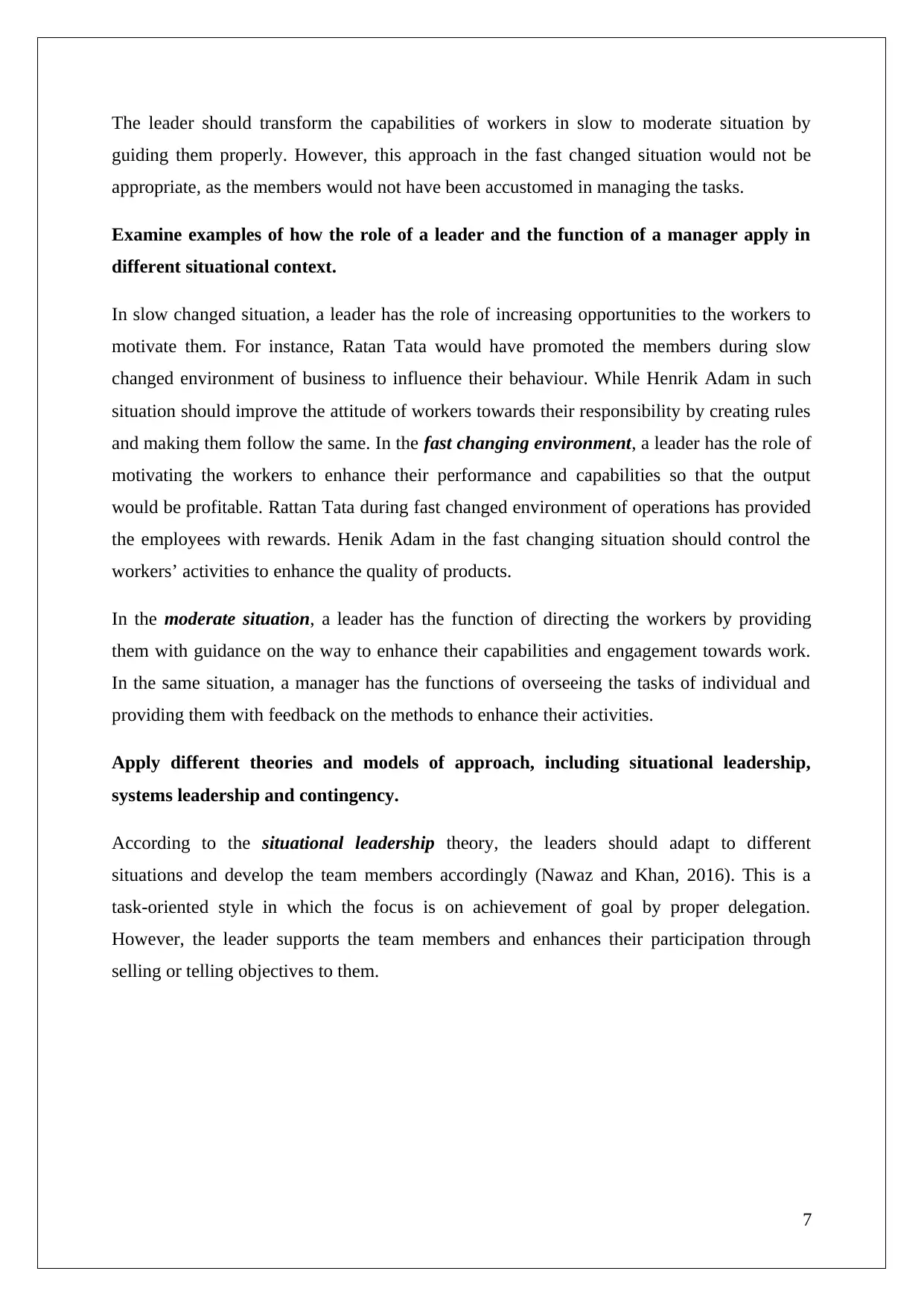
The leader should transform the capabilities of workers in slow to moderate situation by
guiding them properly. However, this approach in the fast changed situation would not be
appropriate, as the members would not have been accustomed in managing the tasks.
Examine examples of how the role of a leader and the function of a manager apply in
different situational context.
In slow changed situation, a leader has the role of increasing opportunities to the workers to
motivate them. For instance, Ratan Tata would have promoted the members during slow
changed environment of business to influence their behaviour. While Henrik Adam in such
situation should improve the attitude of workers towards their responsibility by creating rules
and making them follow the same. In the fast changing environment, a leader has the role of
motivating the workers to enhance their performance and capabilities so that the output
would be profitable. Rattan Tata during fast changed environment of operations has provided
the employees with rewards. Henik Adam in the fast changing situation should control the
workers’ activities to enhance the quality of products.
In the moderate situation, a leader has the function of directing the workers by providing
them with guidance on the way to enhance their capabilities and engagement towards work.
In the same situation, a manager has the functions of overseeing the tasks of individual and
providing them with feedback on the methods to enhance their activities.
Apply different theories and models of approach, including situational leadership,
systems leadership and contingency.
According to the situational leadership theory, the leaders should adapt to different
situations and develop the team members accordingly (Nawaz and Khan, 2016). This is a
task-oriented style in which the focus is on achievement of goal by proper delegation.
However, the leader supports the team members and enhances their participation through
selling or telling objectives to them.
7
guiding them properly. However, this approach in the fast changed situation would not be
appropriate, as the members would not have been accustomed in managing the tasks.
Examine examples of how the role of a leader and the function of a manager apply in
different situational context.
In slow changed situation, a leader has the role of increasing opportunities to the workers to
motivate them. For instance, Ratan Tata would have promoted the members during slow
changed environment of business to influence their behaviour. While Henrik Adam in such
situation should improve the attitude of workers towards their responsibility by creating rules
and making them follow the same. In the fast changing environment, a leader has the role of
motivating the workers to enhance their performance and capabilities so that the output
would be profitable. Rattan Tata during fast changed environment of operations has provided
the employees with rewards. Henik Adam in the fast changing situation should control the
workers’ activities to enhance the quality of products.
In the moderate situation, a leader has the function of directing the workers by providing
them with guidance on the way to enhance their capabilities and engagement towards work.
In the same situation, a manager has the functions of overseeing the tasks of individual and
providing them with feedback on the methods to enhance their activities.
Apply different theories and models of approach, including situational leadership,
systems leadership and contingency.
According to the situational leadership theory, the leaders should adapt to different
situations and develop the team members accordingly (Nawaz and Khan, 2016). This is a
task-oriented style in which the focus is on achievement of goal by proper delegation.
However, the leader supports the team members and enhances their participation through
selling or telling objectives to them.
7
Paraphrase This Document
Need a fresh take? Get an instant paraphrase of this document with our AI Paraphraser
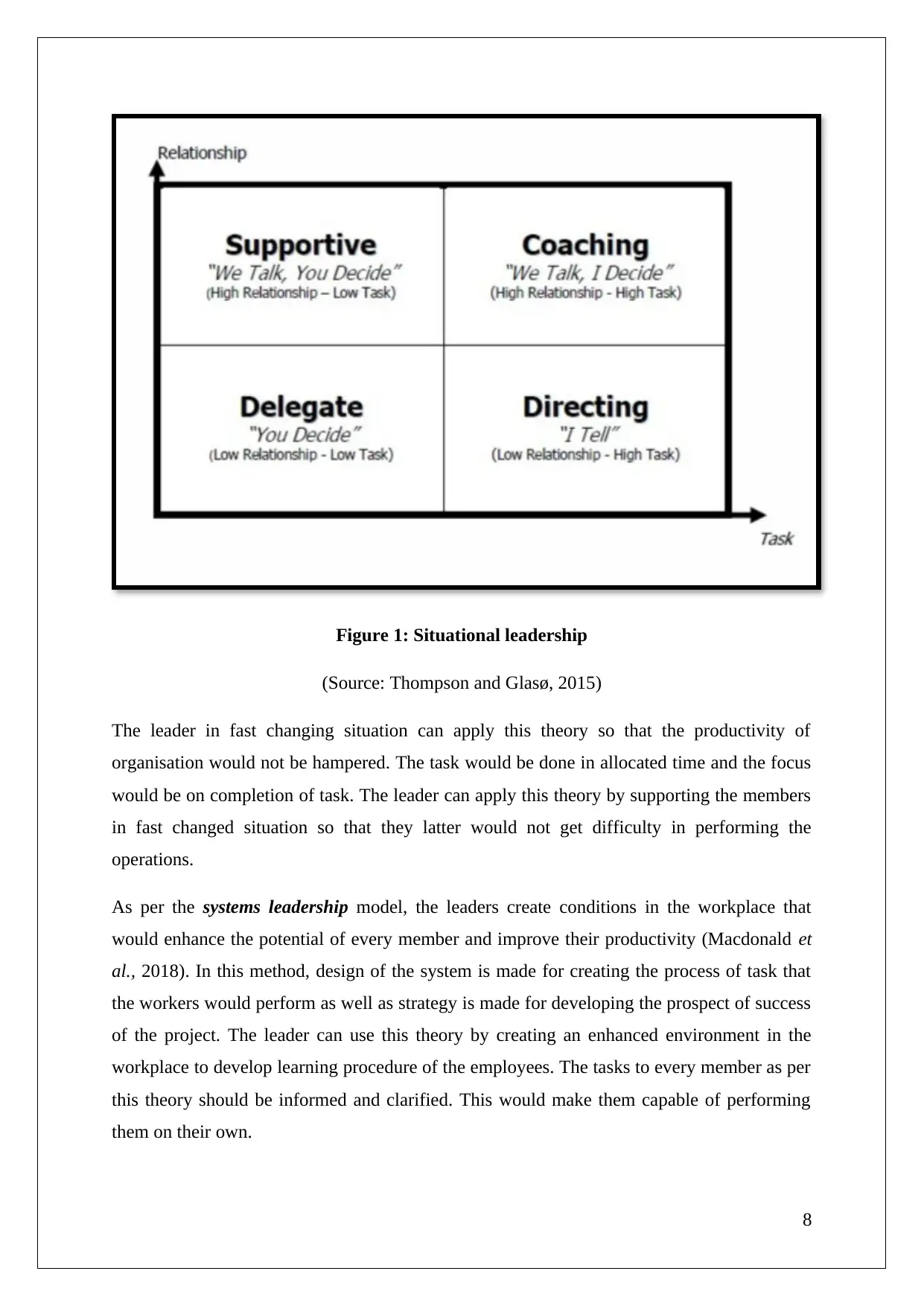
Figure 1: Situational leadership
(Source: Thompson and Glasø, 2015)
The leader in fast changing situation can apply this theory so that the productivity of
organisation would not be hampered. The task would be done in allocated time and the focus
would be on completion of task. The leader can apply this theory by supporting the members
in fast changed situation so that they latter would not get difficulty in performing the
operations.
As per the systems leadership model, the leaders create conditions in the workplace that
would enhance the potential of every member and improve their productivity (Macdonald et
al., 2018). In this method, design of the system is made for creating the process of task that
the workers would perform as well as strategy is made for developing the prospect of success
of the project. The leader can use this theory by creating an enhanced environment in the
workplace to develop learning procedure of the employees. The tasks to every member as per
this theory should be informed and clarified. This would make them capable of performing
them on their own.
8
(Source: Thompson and Glasø, 2015)
The leader in fast changing situation can apply this theory so that the productivity of
organisation would not be hampered. The task would be done in allocated time and the focus
would be on completion of task. The leader can apply this theory by supporting the members
in fast changed situation so that they latter would not get difficulty in performing the
operations.
As per the systems leadership model, the leaders create conditions in the workplace that
would enhance the potential of every member and improve their productivity (Macdonald et
al., 2018). In this method, design of the system is made for creating the process of task that
the workers would perform as well as strategy is made for developing the prospect of success
of the project. The leader can use this theory by creating an enhanced environment in the
workplace to develop learning procedure of the employees. The tasks to every member as per
this theory should be informed and clarified. This would make them capable of performing
them on their own.
8
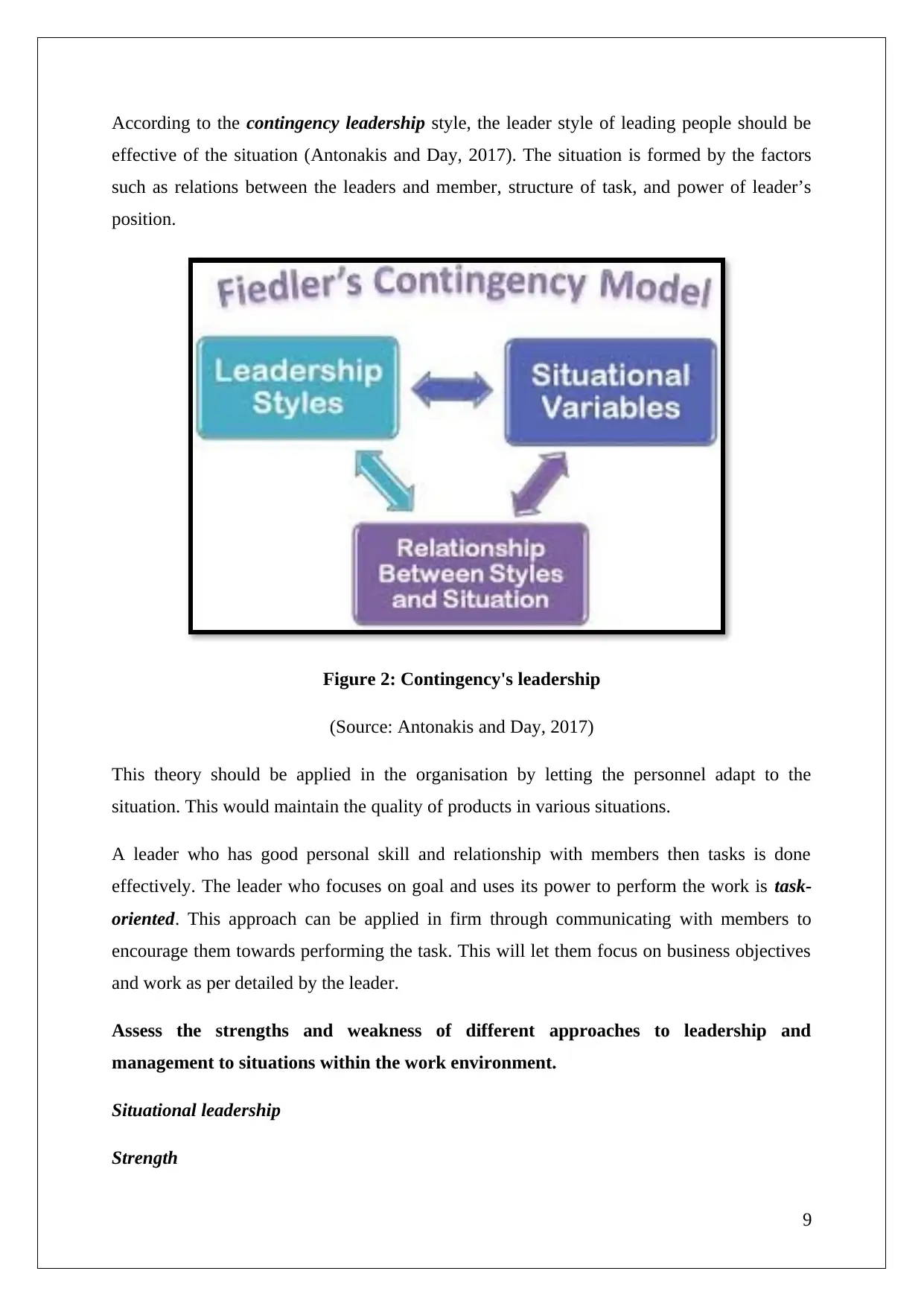
According to the contingency leadership style, the leader style of leading people should be
effective of the situation (Antonakis and Day, 2017). The situation is formed by the factors
such as relations between the leaders and member, structure of task, and power of leader’s
position.
Figure 2: Contingency's leadership
(Source: Antonakis and Day, 2017)
This theory should be applied in the organisation by letting the personnel adapt to the
situation. This would maintain the quality of products in various situations.
A leader who has good personal skill and relationship with members then tasks is done
effectively. The leader who focuses on goal and uses its power to perform the work is task-
oriented. This approach can be applied in firm through communicating with members to
encourage them towards performing the task. This will let them focus on business objectives
and work as per detailed by the leader.
Assess the strengths and weakness of different approaches to leadership and
management to situations within the work environment.
Situational leadership
Strength
9
effective of the situation (Antonakis and Day, 2017). The situation is formed by the factors
such as relations between the leaders and member, structure of task, and power of leader’s
position.
Figure 2: Contingency's leadership
(Source: Antonakis and Day, 2017)
This theory should be applied in the organisation by letting the personnel adapt to the
situation. This would maintain the quality of products in various situations.
A leader who has good personal skill and relationship with members then tasks is done
effectively. The leader who focuses on goal and uses its power to perform the work is task-
oriented. This approach can be applied in firm through communicating with members to
encourage them towards performing the task. This will let them focus on business objectives
and work as per detailed by the leader.
Assess the strengths and weakness of different approaches to leadership and
management to situations within the work environment.
Situational leadership
Strength
9
⊘ This is a preview!⊘
Do you want full access?
Subscribe today to unlock all pages.

Trusted by 1+ million students worldwide
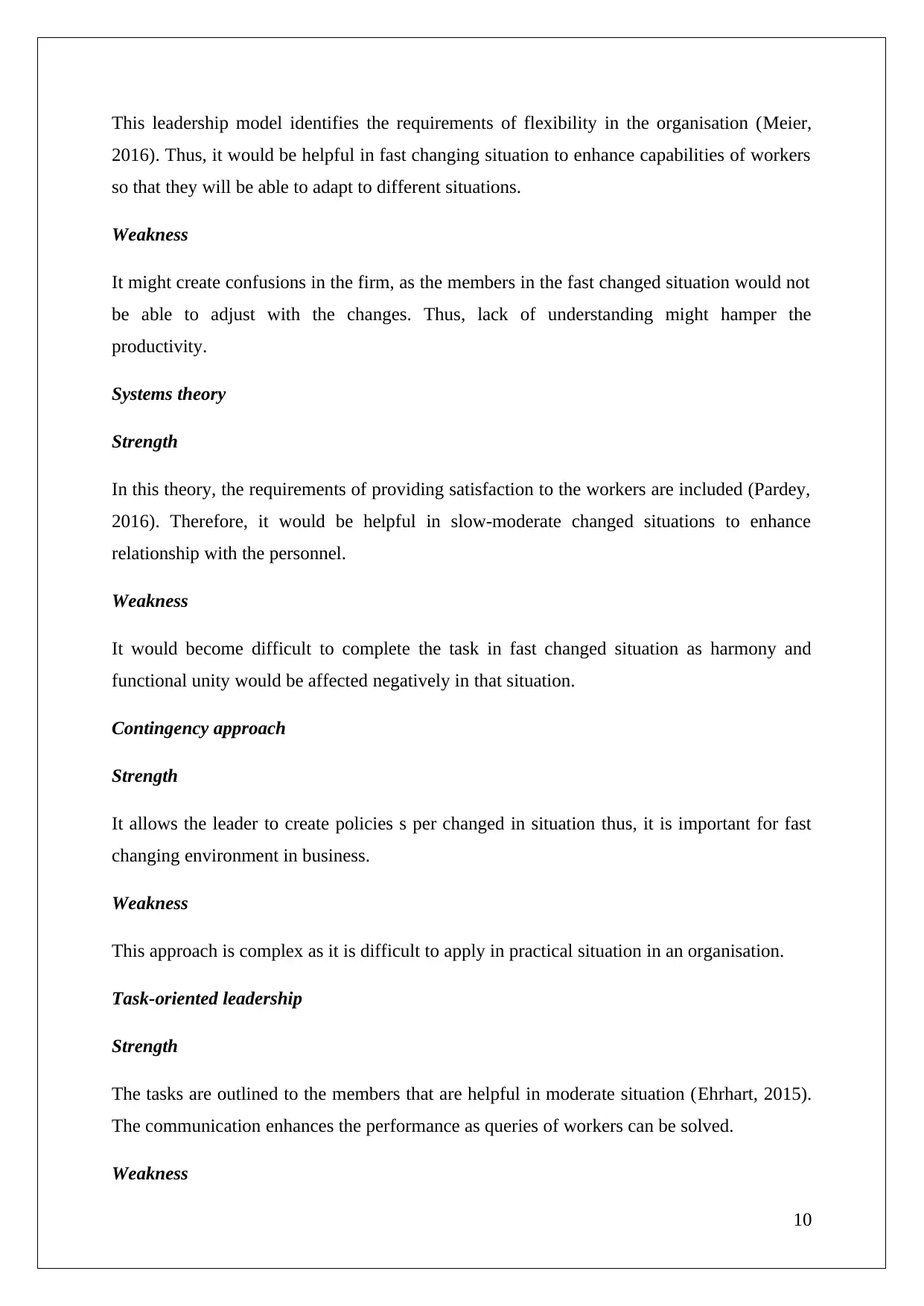
This leadership model identifies the requirements of flexibility in the organisation (Meier,
2016). Thus, it would be helpful in fast changing situation to enhance capabilities of workers
so that they will be able to adapt to different situations.
Weakness
It might create confusions in the firm, as the members in the fast changed situation would not
be able to adjust with the changes. Thus, lack of understanding might hamper the
productivity.
Systems theory
Strength
In this theory, the requirements of providing satisfaction to the workers are included (Pardey,
2016). Therefore, it would be helpful in slow-moderate changed situations to enhance
relationship with the personnel.
Weakness
It would become difficult to complete the task in fast changed situation as harmony and
functional unity would be affected negatively in that situation.
Contingency approach
Strength
It allows the leader to create policies s per changed in situation thus, it is important for fast
changing environment in business.
Weakness
This approach is complex as it is difficult to apply in practical situation in an organisation.
Task-oriented leadership
Strength
The tasks are outlined to the members that are helpful in moderate situation (Ehrhart, 2015).
The communication enhances the performance as queries of workers can be solved.
Weakness
10
2016). Thus, it would be helpful in fast changing situation to enhance capabilities of workers
so that they will be able to adapt to different situations.
Weakness
It might create confusions in the firm, as the members in the fast changed situation would not
be able to adjust with the changes. Thus, lack of understanding might hamper the
productivity.
Systems theory
Strength
In this theory, the requirements of providing satisfaction to the workers are included (Pardey,
2016). Therefore, it would be helpful in slow-moderate changed situations to enhance
relationship with the personnel.
Weakness
It would become difficult to complete the task in fast changed situation as harmony and
functional unity would be affected negatively in that situation.
Contingency approach
Strength
It allows the leader to create policies s per changed in situation thus, it is important for fast
changing environment in business.
Weakness
This approach is complex as it is difficult to apply in practical situation in an organisation.
Task-oriented leadership
Strength
The tasks are outlined to the members that are helpful in moderate situation (Ehrhart, 2015).
The communication enhances the performance as queries of workers can be solved.
Weakness
10
Paraphrase This Document
Need a fresh take? Get an instant paraphrase of this document with our AI Paraphraser
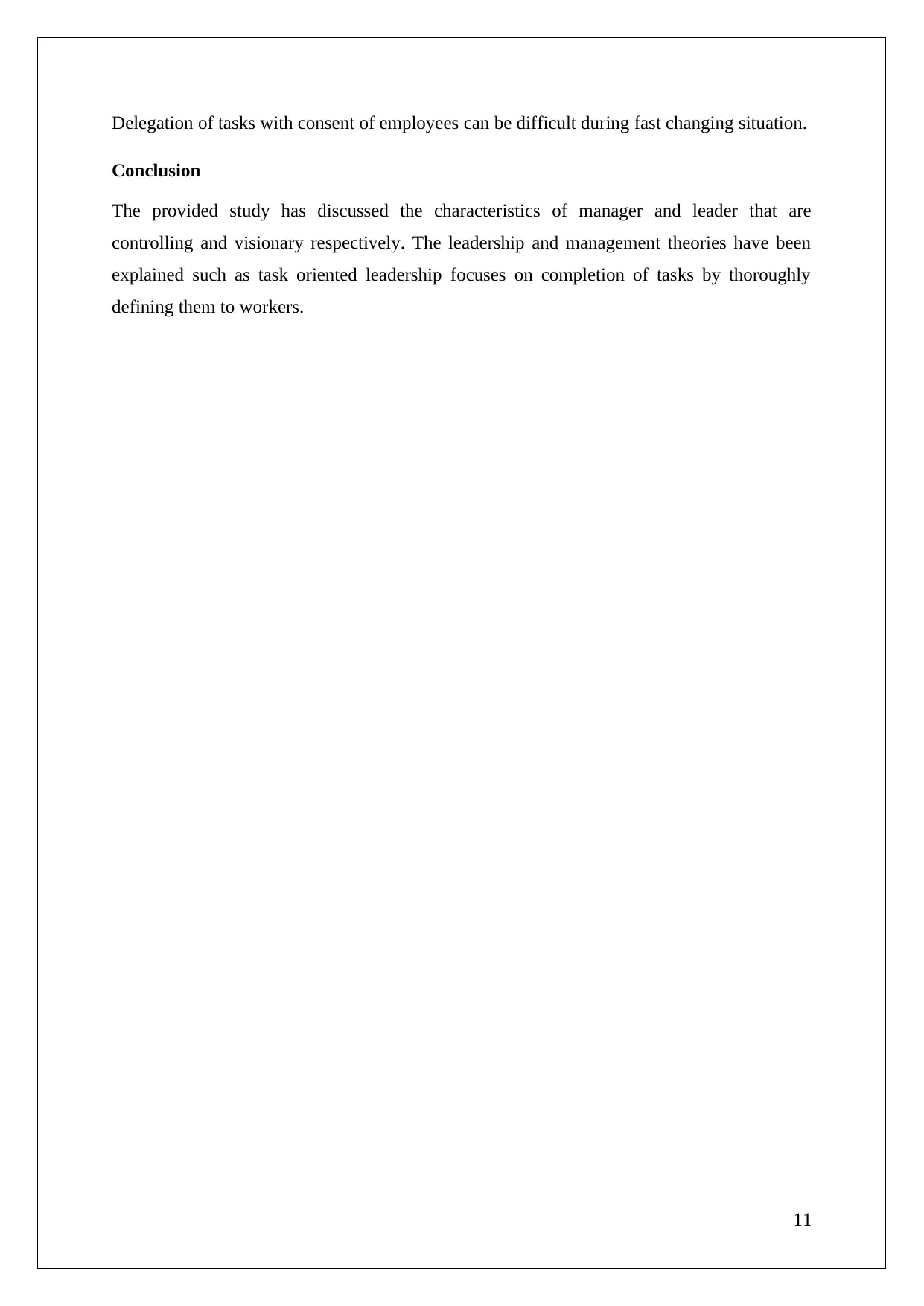
Delegation of tasks with consent of employees can be difficult during fast changing situation.
Conclusion
The provided study has discussed the characteristics of manager and leader that are
controlling and visionary respectively. The leadership and management theories have been
explained such as task oriented leadership focuses on completion of tasks by thoroughly
defining them to workers.
11
Conclusion
The provided study has discussed the characteristics of manager and leader that are
controlling and visionary respectively. The leadership and management theories have been
explained such as task oriented leadership focuses on completion of tasks by thoroughly
defining them to workers.
11
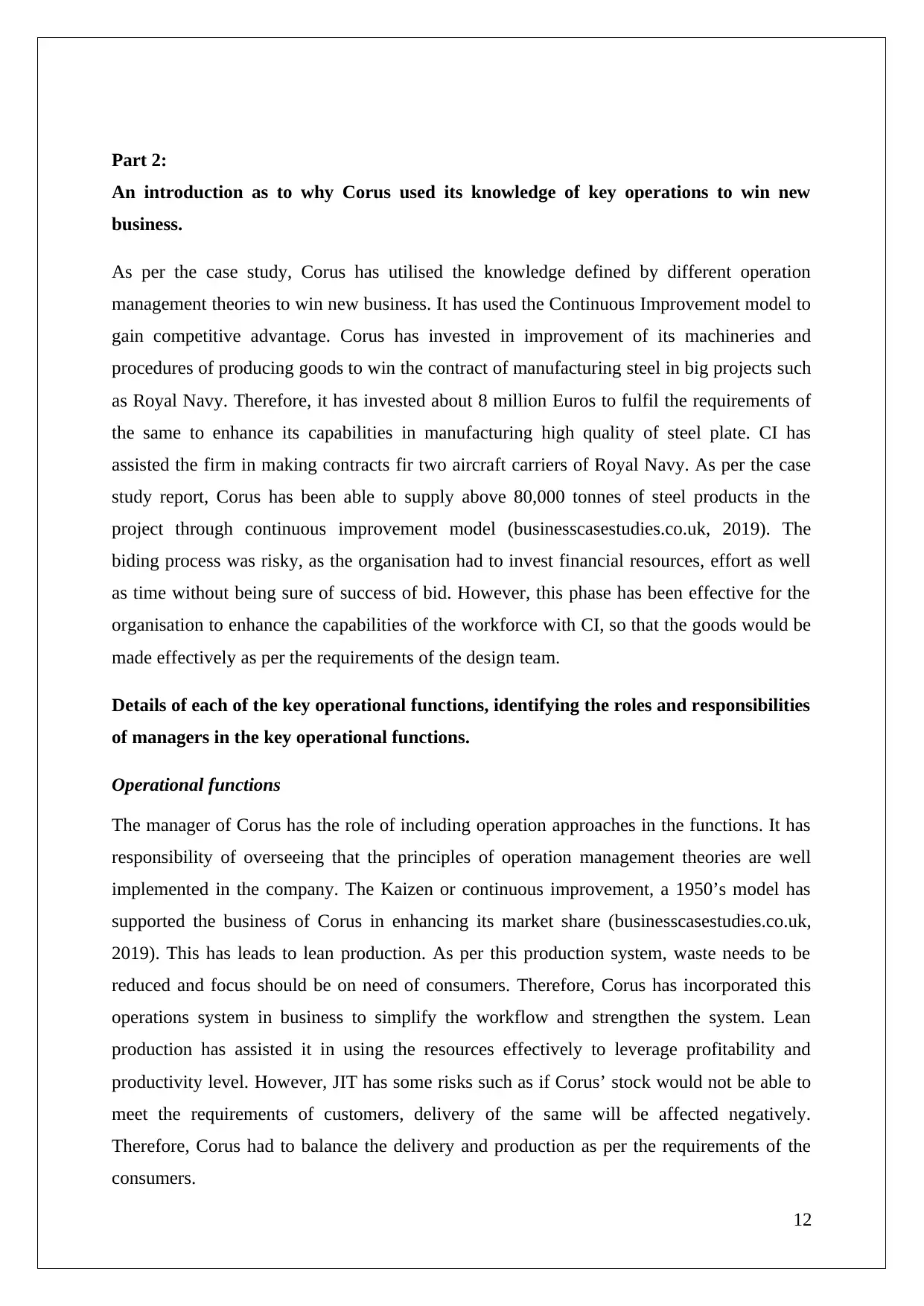
Part 2:
An introduction as to why Corus used its knowledge of key operations to win new
business.
As per the case study, Corus has utilised the knowledge defined by different operation
management theories to win new business. It has used the Continuous Improvement model to
gain competitive advantage. Corus has invested in improvement of its machineries and
procedures of producing goods to win the contract of manufacturing steel in big projects such
as Royal Navy. Therefore, it has invested about 8 million Euros to fulfil the requirements of
the same to enhance its capabilities in manufacturing high quality of steel plate. CI has
assisted the firm in making contracts fir two aircraft carriers of Royal Navy. As per the case
study report, Corus has been able to supply above 80,000 tonnes of steel products in the
project through continuous improvement model (businesscasestudies.co.uk, 2019). The
biding process was risky, as the organisation had to invest financial resources, effort as well
as time without being sure of success of bid. However, this phase has been effective for the
organisation to enhance the capabilities of the workforce with CI, so that the goods would be
made effectively as per the requirements of the design team.
Details of each of the key operational functions, identifying the roles and responsibilities
of managers in the key operational functions.
Operational functions
The manager of Corus has the role of including operation approaches in the functions. It has
responsibility of overseeing that the principles of operation management theories are well
implemented in the company. The Kaizen or continuous improvement, a 1950’s model has
supported the business of Corus in enhancing its market share (businesscasestudies.co.uk,
2019). This has leads to lean production. As per this production system, waste needs to be
reduced and focus should be on need of consumers. Therefore, Corus has incorporated this
operations system in business to simplify the workflow and strengthen the system. Lean
production has assisted it in using the resources effectively to leverage profitability and
productivity level. However, JIT has some risks such as if Corus’ stock would not be able to
meet the requirements of customers, delivery of the same will be affected negatively.
Therefore, Corus had to balance the delivery and production as per the requirements of the
consumers.
12
An introduction as to why Corus used its knowledge of key operations to win new
business.
As per the case study, Corus has utilised the knowledge defined by different operation
management theories to win new business. It has used the Continuous Improvement model to
gain competitive advantage. Corus has invested in improvement of its machineries and
procedures of producing goods to win the contract of manufacturing steel in big projects such
as Royal Navy. Therefore, it has invested about 8 million Euros to fulfil the requirements of
the same to enhance its capabilities in manufacturing high quality of steel plate. CI has
assisted the firm in making contracts fir two aircraft carriers of Royal Navy. As per the case
study report, Corus has been able to supply above 80,000 tonnes of steel products in the
project through continuous improvement model (businesscasestudies.co.uk, 2019). The
biding process was risky, as the organisation had to invest financial resources, effort as well
as time without being sure of success of bid. However, this phase has been effective for the
organisation to enhance the capabilities of the workforce with CI, so that the goods would be
made effectively as per the requirements of the design team.
Details of each of the key operational functions, identifying the roles and responsibilities
of managers in the key operational functions.
Operational functions
The manager of Corus has the role of including operation approaches in the functions. It has
responsibility of overseeing that the principles of operation management theories are well
implemented in the company. The Kaizen or continuous improvement, a 1950’s model has
supported the business of Corus in enhancing its market share (businesscasestudies.co.uk,
2019). This has leads to lean production. As per this production system, waste needs to be
reduced and focus should be on need of consumers. Therefore, Corus has incorporated this
operations system in business to simplify the workflow and strengthen the system. Lean
production has assisted it in using the resources effectively to leverage profitability and
productivity level. However, JIT has some risks such as if Corus’ stock would not be able to
meet the requirements of customers, delivery of the same will be affected negatively.
Therefore, Corus had to balance the delivery and production as per the requirements of the
consumers.
12
⊘ This is a preview!⊘
Do you want full access?
Subscribe today to unlock all pages.

Trusted by 1+ million students worldwide
1 out of 21
Related Documents
Your All-in-One AI-Powered Toolkit for Academic Success.
+13062052269
info@desklib.com
Available 24*7 on WhatsApp / Email
![[object Object]](/_next/static/media/star-bottom.7253800d.svg)
Unlock your academic potential
Copyright © 2020–2025 A2Z Services. All Rights Reserved. Developed and managed by ZUCOL.





